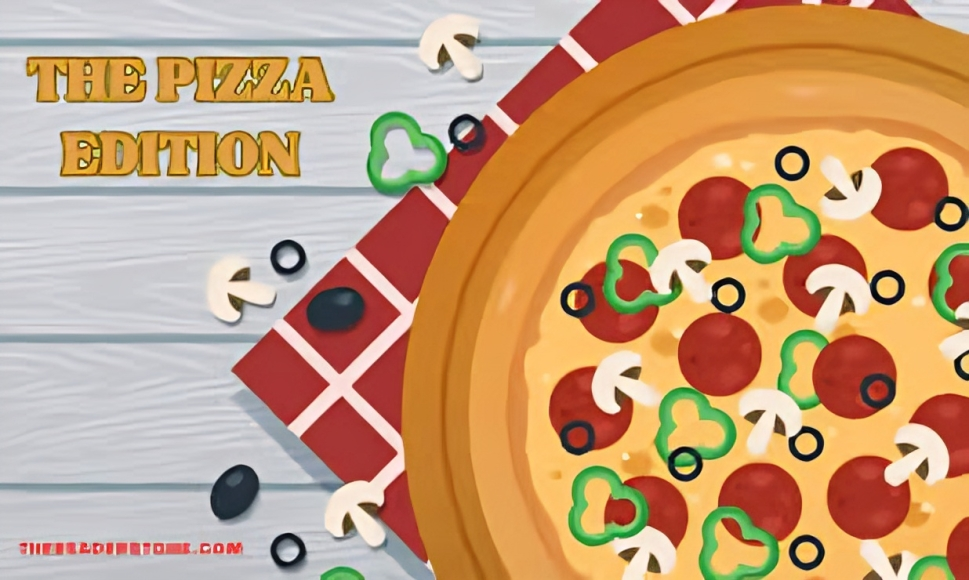The Pizza Edition, a culinary delight that transcends borders, has woven itself into the fabric of global cuisine. From its humble origins in Naples, Italy, to its status as a worldwide favorite, pizza’s journey is a testament to its universal appeal. This article delves into the rich history, cultural significance, regional variations, and modern innovations of pizza, celebrating its enduring popularity and versatility.
The Origins of The Pizza Edition

Ancient Beginnings
The concept of The Pizza Edition can be traced back to ancient civilizations. The Greeks and Egyptians baked flatbreads with toppings, a precursor to modern pizza. However, it was in Naples, during the 18th century, that pizza as we know it began to take shape. The working class in Naples needed affordable and quick meals, leading to the creation of flatbreads topped with tomatoes, cheese, oil, and other ingredients.
The Birth of the Margherita
In 1889, Queen Margherita of Savoy visited Naples. Chef Raffaele Esposito prepared a special pizza in her honor, featuring tomatoes, mozzarella, and basil, representing the colors of the Italian flag. This creation, named Pizza Margherita, became a symbol of Italian national pride and helped elevate pizza from street food to a dish fit for royalty.
Pizza’s Journey Across the Globe
Arrival in the United States
Italian immigrants brought pizza to the United States in the late 19th and early 20th centuries. Initially, it remained a niche ethnic dish, confined to Italian communities. The first pizzeria in the U.S., Lombardi’s, opened in New York City in 1905. However, it wasn’t until after World War II that pizza began to gain mainstream popularity. Returning soldiers who had tasted pizza in Italy spurred its demand, leading to the proliferation of pizzerias across the country.
Global Expansion
Pizza’s global spread accelerated in the latter half of the 20th century. Its adaptability to local tastes and ingredients facilitated its acceptance and popularity in diverse cultures. Today, pizza is a staple in countries as varied as Japan, Brazil, India, and South Africa, each putting their unique spin on the classic dish.
Regional Variations
Italy: The Traditionalists
In Italy, pizza remains deeply rooted in tradition. The two main styles are Neapolitan and Roman. Neapolitan pizza is known for its soft, chewy crust, simple toppings, and a slightly charred base due to high-temperature cooking in a wood-fired oven. Roman The Pizza Edition, on the other hand, has a thinner, crispier crust and often includes a wider variety of toppings.
United States: A Melting Pot of Styles
The U.S. has developed numerous regional pizza styles, each with its distinct characteristics:
- New York-Style: Known for its large, foldable slices and thin crust, New York-style pizza is often sold by the slice. Its simple toppings typically include mozzarella cheese and tomato sauce.
- Chicago Deep-Dish: This style features a thick, buttery crust and layers of cheese, toppings, and chunky tomato sauce. Baked in a deep pan, it’s more akin to a pie than a traditional pizza.
- California Style: Emphasizing fresh, non-traditional toppings such as arugula, goat cheese, and smoked salmon, California pizza showcases the state’s innovative and health-conscious culinary scene.
- Detroit Style: Rectangular with a thick, crispy crust, Detroit pizza is baked in a steel pan, resulting in a caramelized cheese edge. Toppings are layered beneath the sauce, creating a unique flavor profile.
Other Notable International Styles
- Japan: Japanese pizza often features unconventional toppings like mayonnaise, seafood, and teriyaki chicken. Okonomiyaki, a savory pancake, is sometimes referred to as Japanese pizza.
- Brazil: Brazilian pizzas are known for their diverse toppings, including ingredients like heart of palm, catupiry cheese, and even chocolate. Pizzerias in Brazil often offer extensive menus with dozens of topping combinations.
- India: Indian pizzas incorporate local flavors and spices, with toppings like paneer, tandoori chicken, and spicy chutneys. The crust is sometimes made from naan or other traditional Indian breads.
The Art of Pizza Making
The Dough
A pizza’s foundation is its dough, and the quality of the dough can make or break the final product. Traditional Neapolitan dough is made with just four ingredients: flour, water, salt, and yeast. The dough is left to ferment for several hours, developing a rich, complex flavor. In contrast, American styles like New York and Chicago may incorporate oil and sugar to achieve different textures and flavors.
The Sauce
Pizza sauce varies widely depending on regional preferences. The traditional Neapolitan sauce consists of simple, uncooked crushed tomatoes seasoned with salt, occasionally infused with basil for flavor. American sauces often include additional herbs, garlic, and a hint of sweetness.
The Cheese
Mozzarella is the quintessential pizza cheese, prized for its meltability and mild flavor. Fresh mozzarella, often used in Neapolitan pizza, offers a creamy texture and delicate taste. In the U.S., low-moisture mozzarella is more common, providing a more elastic and chewy consistency. Additional cheeses such as provolone, cheddar, and Parmesan are incorporated to enhance the depth and richness of flavors.
Toppings
The sky’s the limit when it comes to pizza toppings. Traditional options include pepperoni, sausage, mushrooms, and bell peppers. However, as pizza has spread globally, so too have the variety of toppings. From pineapple and ham in Hawaii to potatoes and rosemary in Italy, toppings reflect local tastes and culinary traditions.
Modern Innovations
Health-Conscious Pizzas
With growing awareness of health and dietary preferences, pizza has evolved to cater to diverse needs. Gluten-free crusts, vegan cheeses, and organic ingredients are now common offerings in many pizzerias. Cauliflower crusts and whole-grain bases provide healthier alternatives without sacrificing flavor.
Gourmet Pizzas
The rise of gourmet pizzas has elevated the dish to new culinary heights. Artisanal pizzerias experiment with high-quality ingredients, unique flavor combinations, and creative presentations. Gourmet pizzas feature truffle oil, prosciutto, arugula, and exotic cheeses among their deliciously crafted ingredients for exquisite flavors.
Technology and Convenience
Technology has also played a significant role in modernizing pizza. Online ordering, delivery apps, and contactless payment options have made enjoying pizza more convenient than ever. Additionally, innovations like automated pizza-making machines and delivery drones are shaping the future of the industry.
The Cultural Impact of Pizza
Pop Culture Icon
Pizza’s influence extends beyond the culinary world into popular culture. It frequently appears in movies, TV shows, and even music. Iconic scenes, such as the pizza delivery in “Home Alone” or the Teenage Mutant Ninja Turtles’ love for The Pizza Edition, have cemented its place in entertainment.
Social and Community Aspect
Pizza is inherently a social food, often shared among friends and family. Pizza parties, whether at home or in pizzerias, are a popular way to celebrate birthdays, sports events, and other gatherings. The communal aspect of pizza fosters a sense of togetherness and enjoyment.
Pizza Challenges and Competitions
Pizza-making has become a competitive art form, with contests and festivals dedicated to the craft. The World Pizza Championship in Parma, Italy, and the International Pizza Expo in Las Vegas are two of the most prestigious events, attracting top pizzaiolos from around the world to showcase their skills and creativity.
FAQs
1. What are the origins of pizza?
Pizza traces its origins to ancient civilizations like the Greeks and Egyptians, who baked flatbreads topped with various ingredients. Modern pizza, as known today, originated in 18th-century Naples, Italy, designed as an inexpensive meal for the working class.
2. How did Pizza Margherita get its name?
Pizza Margherita was named after Queen Margherita of Savoy. In 1889, chef Raffaele Esposito prepared a pizza for her featuring tomatoes, mozzarella, and basil, representing the colors of the Italian flag. This pizza became a symbol of Italian national pride.
3. When did pizza first come to the United States?
Italian immigrants introduced pizza to the United States in the late 19th and early 20th centuries. The first pizzeria in the U.S., Lombardi’s, opened in New York City in 1905.
4. What are the main styles of pizza in Italy?
The two main styles of The Pizza Edition in Italy are Neapolitan and Roman. Neapolitan pizza has a soft, chewy crust with simple toppings, while Roman pizza is thin, crispy, and offers diverse toppings.
5. What are some popular regional pizza styles in the United States?
- New York-Style: Known for its large, foldable slices and thin crust.
- Chicago Deep-Dish: Features a thick, buttery crust and layers of cheese, toppings, and chunky tomato sauce.
- California Style: Uses fresh, non-traditional toppings like arugula and goat cheese.
- Detroit Style: Rectangular with a thick, crispy crust, baked in a steel pan for a caramelized cheese edge.
Conclusion
The Pizza Edition, with its rich history and global appeal, continues to captivate people of all ages and backgrounds. Its ability to adapt and evolve while maintaining its core essence is a testament to its enduring popularity. Whether you prefer a classic Margherita, a deep-dish Chicago style, or an experimental gourmet creation, pizza offers something for everyone. As it continues to evolve and inspire, pizza remains a beloved and iconic dish that transcends culinary boundaries.



